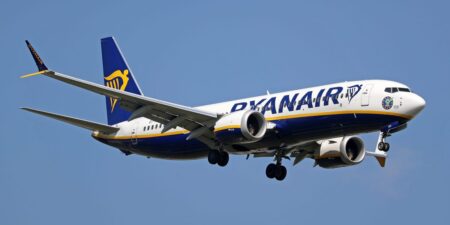- Spirit Airlines may file for Chapter 11 amid major debts after a failed merger with JetBlue.
- The airline is saddled with debt of about $3.3 billion.
- A report of the potential bankruptcy filing sent Spirit’s stock tumbling in premarket trade Friday.
Spirit Airlines stock plunged in premarket trading on Friday after a report that it may file for Chapter 11 bankruptcy protection.
Following a failed merger with JetBlue Airways, Spirit had been grappling with heavy losses, making it difficult to manage its $3.3 billion debt load that includes $1.1 billion of secured bonds due within the next year, The Wall Street Journal reported late Thursday.
The budget airline is also exploring restructuring options to alleviate some of its financial pressures, though no filing is imminent, the Journal reported.
The report pushed the carrier’s stock down as much as 36% in premarket trade on Friday. The shares have fallen 86% this year.
CEO Ted Christie said on an August earnings call that Spirit was in talks with advisors and bondholders over its debt.
While Spirit faces a turbulent future with a potential Chapter 11 filing, it isn’t necessarily a death sentence for the airline. Rather, Chapter 11 allows businesses to reorganize their debts while continuing their operations. Other airlines have used the process to stay afloat.
Most recently, Scandinavian Airlines filed for Chapter 11 in the US in 2022 following a pilot strike. The airline underwent a $3 billion restructuring plan to revise its fleet and raise money, while continuing to operate. The company emerged from bankruptcy in August.
In 2007, Delta Airlines filed for bankruptcy after shedding 6,000 jobs and slashing $1 billion in labor costs. By optimizing its Atlanta hub and increasing its international routes, the company successfully recovered from its financial troubles and remains one of the largest airlines in the US.
A potential bankruptcy filing could serve as a similar lifeline for Spirit’s management of debt and finances.
This came as Spirit bumped its ticketing prices in July, shifting away from its ultra-low-cost model to boost revenue after suffering a $143 million loss in the first quarter of this year and a $193 million loss in the second quarter.
Spirit has been bogged by annual losses since before the COVID-19 pandemic, despite the travel industry’s recovery, and continues to struggle against larger airlines that offer competitive fares.
The airline has cut routes, furloughed pilots, and shrunk its operational capacity by nearly 20%.
Spirit Airlines did not respond to a request for comment from Business Insider outside normal working hours.
Read the full article here
















